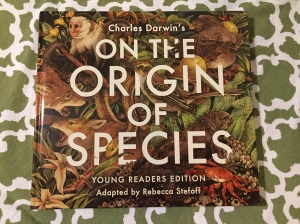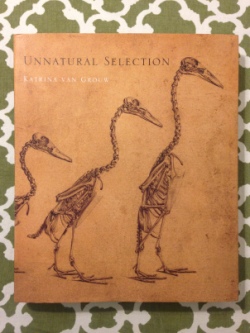‘Tis the season for holiday gift giving (to others or to yourself, no shame there), so I thought I’d share about some recent books about evolution and related topics that might strike in you a desire to spread the good news (of science!).
FOR YOUNGER READERS
Rebecca Stefoff and Teagan White (illustrator), Charles Darwin’s On the Origin of Species: Young Readers Edition (New York: Atheneum Books for Young Readers, 2018, 176. pp.) ~ As she has done for other books (Howard Zinn’s A People’s History of the United States, Jared Diamond’s The Third Chimpanzee, and Charles C. Mann’s 1493), Stefoff has taken an important book and adapted it for a younger audience, using more accessible language and including copious illustrations and photographs, and while remaining true to Darwin’s chapter structure, has provided updated information on topics that have, well, evolved since Darwin’s time. If On the Origin of Species continues to be a book that everyone has an opinion about yet have never actually read (it can be a challenging read), perhaps they can start with this handsome large format edition. It surely deserves a place on the shelves of middle and high school libraries. Order Charles Darwin’s On the Origin of Species: Young Readers Edition: Amazon, Powell’s, Barnes & Noble, Indiebound.
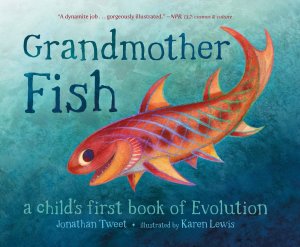
Jonathan Tweet and Karen Lewis (illustrator), Grandmother Fish (New York: Feiwel & Friends, 2016, 32 pp.) ~ This fantastic book about evolution for preschool-aged kids is not new, but I shared about it previously and it is worth mentioning again! Order Grandmother Fish: Amazon, Powell’s, Barnes & Noble, Indiebound.
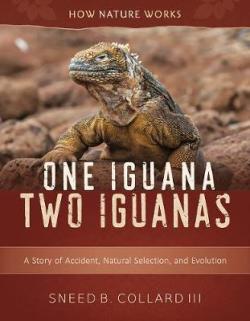
Sneed B. Collard III, One Iguana, Two Iguanas: A Story of Accident, Natural Selection, and Evolution (Thomaston, ME: Tilbury House, 2018, 48 pp.) ~ I have not looked at a copy of this book myself, but Greg Laden has. Here’s the publisher’s description: “Natural selection and speciation are all but ignored in children’s nonfiction. To help address this glaring deficiency, award-winning children’s science writer Sneed Collard traveled to the Galapagos Islands to see for himself, where Charles Darwin saw, how new species form. The result is this fascinating story of two species of iguana, one land-based and one marine, both of which developed from a single ancestor that reached the islands millions of years ago. The animals evolved in different directions while living within sight of one another. How is that possible?” Geared toward upper elementary and middle grade readers. Order One Iguana, Two Iguanas: A Story of Accident, Natural Selection, and Evolution: Amazon, Powell’s, Barnes & Noble, Indiebound.
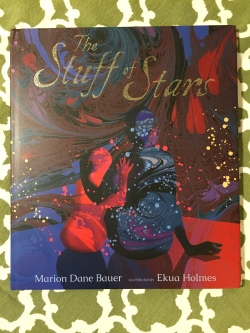
Marion Dane Bauer and Ekua Holmes, Ekua (illustrator), The Stuff of Stars (Somerville, MA: Candlewick Press, 2018, 40 pp.) ~ Going further back that biological evolution, this book puts the Sagan-esque notion of everything being made of “star stuff” – that all the matter that makes up every organism, including humans, was first created in the furnaces of stars billions of years ago – into a beautiful presentation of words and art. For some science-minded people who live without religion, appreciating our elemental connection to the universe can serve as a secular spirituality, and The Stuff of Stars serves as a perfect introduction of this idea. Order The Stuff of Stars: Amazon, Powell’s, Barnes & Noble, Indiebound.
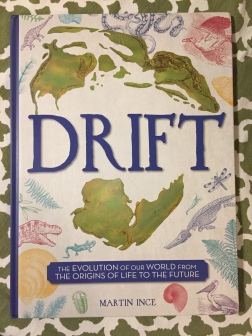
Ince, Martin, Continental Drift: The Evolution of Our World from the Origins of Life to the Future (Blueprint Editions, 80 pp.; titled Drift in the UK for WeldonOwen Publishing) ~ It is difficult to discuss the evolution of animals on Earth without bringing in geology: how plates of earth’s crusts moving around the globe over millions of years has had a major effect on the evolutionary lineages of organisms. Continental Drift by science writer Martin Ince, begins with the formation of Earth 4.5 billions years ago and the formation of land around 3.4 bya, and then passes through periods of geologic time (Cambrian, Devonian, Permian, Jurassic, Cretaceous, Paleogene, Anthropocene, etc.), describing the movement of plates and evolution of organisms during those periods. Copiously illustrated with drawings and photographs, as well as large maps showing how the earth’s land appeared in each period, this book is perfect for upper elementary and middle grade students wishing to learn more about the history of our planet and its life. In fact, curious adults will find value in pouring through its pages. Order Drift: Amazon, Powell’s, Barnes & Noble, Indiebound.
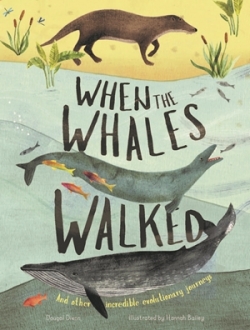
Dougal Dixon and Hannah Bailey (illustrator), When the Whales Walked: And Other Incredible Evolutionary Journeys (London: words & pictures, 2018, 64 pp.) ~ I have not seen a copy of this book yet, but it looks like an important one to teach readers about transitional fossils. The publisher’s description: “Step back in time and discover a world where whales once walked, crocodiles were warm-blooded and snakes had legs! Meet terrifying giant birds, and tiny elephants living on islands in this fascinating creature guide like no other. Learn how whales once walked on four legs before taking to the oceans; how dinosaurs evolved into birds; and how the first cats were small and lived in trees. Featuring a stunning mix of annotated illustrations, illustrated scenes and family trees, evolution is explained here in a captivating and novel style that will make children look at animals in a whole new way.” Order When the Whales Walked: Amazon, Powell’s, Barnes & Noble, Indiebound.
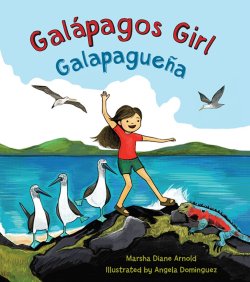
Marsha Diane Arnold and Angela Dominguez (illustrator), Galápagos Girl/Galapagueña (New York: Lee & Low Books, 2018, 40 pp.) ~ This is a charming picture book about a young girl born and raised on Floreana island in the Galápagos, who grew up among its unique animals and has made a life of researching, protecting, and educating about the Galápagos and its wildlife. Her name is Valentina Cruz, and through her story readers will learn about what it means to spend time in nature and value protecting it. The publisher’s description: “For Valentina, living on the Galápagos islands means spending her days outside, observing the natural world around her. She greets sea lions splashing on the shore, scampers over lava rocks with Sally-lightfoot crabs, and swims with manta rays. She is a Galápagos girl, and there is no other place she’d rather be! But this wondrous world is fragile, and when Valentina learns her wild companions are under threat, she vows to help protect them and the islands. Whimsical illustrations by Pura Belpré Honoree Angela Dominguez transport readers to the unique Galápagos islands, which shelter a number of diverse plant and animal species that can be found nowhere else on the planet. Come discover this beautiful world with Valentina and her animal friends!” The book is presented in both English and Spanish, and Mr. Darwin only receives a single mention, in a note at the end of the book about finches. This book is, after all, about Valentina, not Charles, as there are many persons connected to the history of these islands. Order Galápagos Girl/Galapagueña: Amazon, Powell’s, Barnes & Noble, Indiebound.
FOR OLDER READERS
Katrina von Grouw, Unnatural Selection (Princeton University Press, 2013, 304 pp.) ~ This book came out in the summer, but I shared about it previously and it is worth mentioning again! Order Unnatural Selection: Amazon, Powell’s, Barnes & Noble, Indiebound.
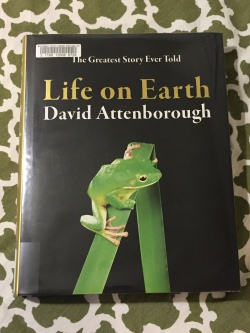
David Attenborough, Life on Earth: The Greatest Story Ever Told (London: William Collins, 2018, 352 pp.) ~ A classic, updated. From the publisher: “David Attenborough’s unforgettable meeting with gorillas became an iconic moment for millions of television viewers. Life on Earth, the series and accompanying book, fundamentally changed the way we view and interact with the natural world setting a new benchmark of quality, influencing a generation of nature lovers. Told through an examination of animal and plant life, this is an astonishing celebration of the evolution of life on earth, with a cast of characters drawn from the whole range of organisms that have ever lived on this planet. Attenborough’s perceptive, dynamic approach to the evolution of millions of species of living organisms takes the reader on an unforgettable journey of discovery from the very first spark of life to the blue and green wonder we know today. Now, to celebrate the 40th anniversary of the book’s first publication, David Attenborough has revisited Life on Earth, completely updating and adding to the original text, taking account of modern scientific discoveries from around the globe. He has chosen beautiful, completely new photography, helping to illustrate the book in a much greater way than was possible forty years ago. This special anniversary edition provides a fitting tribute to an enduring wildlife classic, destined to enthral the generation who saw it when first published and bring it alive for a whole new generation.” Order Life on Earth: Amazon, Powell’s, Barnes & Noble, Indiebound.
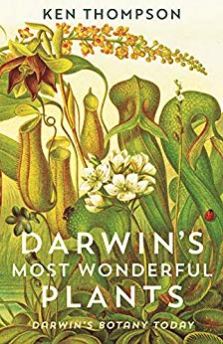
Ken Thompson, Darwin’s Most Wonderful Plants: Darwin’s Botany Today (London: Profile Books, 2018, 256 pp.) ~ In five chapters Thompson takes a look at Darwin’s seven books that cover botanical topics, from his first on orchids in 1862 to The Power of Movement in Plants in 1880. From the publisher: “Ken Thompson sees Darwin as a brilliant and revolutionary botanist, whose observations and theories were far ahead of his time – and are often only now being confirmed and extended by high-tech modern research. Like Darwin, he is fascinated and amazed by the powers of plants – particularly their Triffid-like aspects of movement, hunting and ‘plant intelligence’. This is a much needed book that re-establishes Darwin as a pioneering botanist, whose close observations of plants were crucial to his theories of evolution.” Order Darwin’s Most Wonderful Plants: Amazon, Powell’s, Barnes & Noble, Indiebound.
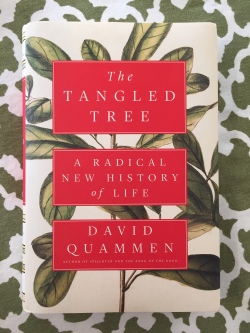
David Quammen, The Tangled Tree: A Radical New History of Life (New York: Simon & Schuster, 2018, 480 pp.) ~ Currently making my way through this new offering from one of the best science writers we have. Quammen tells the intriguing story of how molecular biologists rewrote the tree of life, centering on the work of Carl Woese (billed as one of the most important biologists of the 20th century that you’ve never heard of) but including Lynn Margulis and a great many others. Quammen blends science with storytelling in such a fashion that one feels as if they are witnessing science at work as it is happening – it’s ups and downs, its triumphs and lesser moments. With plenty of Darwin to start the narrative off. Highly recommended. Order The Tangled Tree: Amazon, Powell’s, Barnes & Noble, Indiebound.
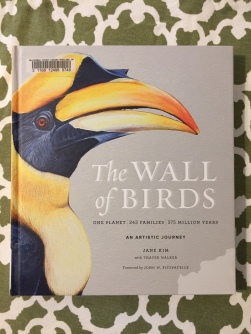
Jane Kim and Thayer Walker, The Wall of Birds: One Planet, 243 Families, 375 Million Years – A Visual Journey (New York: Harper Design, 2018, 224 pp.) ~ Ever since I first saw social media posts showing the work in progress for a mural on a wall at the Cornell Lab of Ornithology‘s office, I have been in awe of Jane Kim’s bird and other scientific illustrations. They are absolutely gorgeous, and this new book by Kim shares her experience doing the mural and about all the birds presented, including dinosaurs! Order The Wall of Birds: Amazon, Powell’s, Barnes & Noble, Indiebound. More info about the wall here, and Jane’s website here.
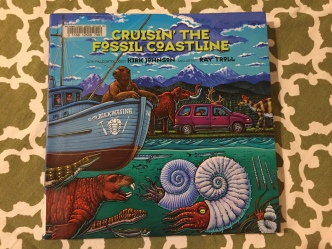
Kirk Johnson and Ray Troll (artist), Cruisin’ the Fossil Coastline: The Travels of an Artist and a Scientist along the Shores of the Prehistoric Pacific (Golden, CO: Fulcrum Publishing, 2018, 290 pp.) ~ A follow up to Johnson and Troll’s Cruisin’ the Fossil Freeway: An Epoch Tale of a Scientist and an Artist on the Ultimate 5,000-mile Paleo Road Trip (2007), which followed the author and artist through the American West in search of fossils and paleontologists, Cruisin’ the Fossil Coastline does the same for the stretch of coastline from southern California up north into Alaska. Johnson is a fine writer, and Troll’s unique art style never disappoints. Order Cruisin’ the Fossil Coastline: Amazon, Powell’s, Barnes & Noble, Indiebound.
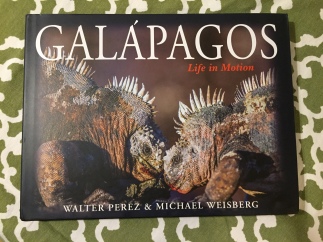
Walter Perez and Michael Weisberg, Galápagos: Life in Motion (Princeton University Press, 2018, 208 pp.) ~ For someone who hopes to visit the Galápagos in their lifetime but is not sure if it will happen, this book of photographs by Walter Perez is an antidote to waiting for such an opportunity. From the publisher: “The Galápagos Islands are home to an amazing variety of iconic creatures, from Giant Tortoises, Galápagos Sea Lions, Galápagos Penguins, and Ghost Crabs to Darwin’s finches, the Blue-footed Booby, and Hummingbird Moths. But how precisely do these animals manage to survive on―and in the waters around―their desert-like volcanic islands, where fresh water is always scarce, food is often hard to come by, and finding a good mate is a challenge because animal populations are so small? In this stunning large-format book, Galápagos experts Walter Perez and Michael Weisberg present an unprecedented photographic account of the remarkable survival behaviors of these beautiful and unique animals. With more than 200 detailed, close-up photographs, the book captures Galápagos animals in action as they feed, play, fight, court, mate, build nests, give birth, raise their young, and cooperate and clash with other species.” Order Galápagos: Life in Motion: Amazon, Powell’s, Barnes & Noble, Indiebound.
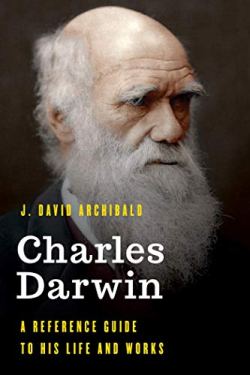
J. David Archibald, Charles Darwin: A Reference Guide to His Life and Works (Lanham, MD: Rowman & Littlefield Publishers, 2018, 232 pp.) ~ I have yet to view a copy of this book, but I have liked Archibald’s other books about Darwin and evolution so I expect this to serve as a useful resource. Here is the publisher’s description: “Charles Darwin: A Reference Guide to His Life and Works provides an important new compendium presenting a detailed chronology of all aspects Darwin’s life. The extensive encyclopedia section includes many hundreds of entries of various kinds related to Darwin – people, places, institutions, concepts, and his publications. The bibliography provides a comprehensive listing of the vast majority of Darwin’s works published during and after his lifetime. It also provides a more selective list of publications concerning his life and work.” Order Charles Darwin: A Reference Guide to His Life and Works: Amazon, Powell’s, Barnes & Noble, Indiebound.

